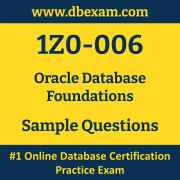01. When should a composite unique identifier be used in a database design?
a) When there is a one-to-one (1:1) relationship between two entities
b) When an entity has a many-to-many (N:N) relationship with another entity
c) When there are multiple attributes that together uniquely identify an entity
d) When a foreign key is used to link two entities together
02. Which database model stores data in objects with attributes and methods, similar to object-oriented programming?
a) Hierarchical Database Model
b) Object-Oriented Database Model
c) Network Database Model
d) Relational Database Model
03. In a database, how is a many-to-many (N:N) relationship between two entities typically resolved?
a) By creating a composite entity (junction table) with foreign keys to both entities
b) By combining the attributes of both entities into a single entity
c) By denormalizing the database structure for better performance
d) By using a one-to-many (1:N) relationship between the entities
04. How is the result set sorted in ascending order using a SELECT statement?
a) ASC
b) DESC
c) ORDER BY <column_name> ASC
d) SORT ASCENDING
05. At which level of data abstraction is the database schema defined?
a) Physical level
b) Logical level
c) External level
d) Conceptual level
06. What does ACID stand for in the context of database transactions?
a) Atomicity, Consistency, Isolation, Durability
b) Aggregate, Commit, Isolate, Distribute
c) Association, Constraint, Index, Data
d) All Columns In Database
07. Why is it important to accurately map entities, columns, and data types in a database?
a) It simplifies the process of creating primary keys for each table.
b) It ensures that data can be retrieved and stored correctly in the database.
c) It eliminates the need for creating relationships between tables.
d) It guarantees that the database can handle a large number of concurrent users.
08. Which of the following activities is NOT part of the requirements gathering process for database design?
a) Creating Entity-Relationship Diagrams (ERDs)
b) Conducting interviews with key stakeholders
c) Analyzing existing data and systems
d) Implementing database security measures
09. When creating a foreign key relationship, which of the following statements is true?
a) The foreign key can be null in the referencing table.
b) The foreign key and primary key must be of different data types.
c) The foreign key must have a unique index applied to it.
d) The foreign key must have the same name as the primary key in the referencing table.
10. What is the highest level of data abstraction in a database system?
a) Physical level
b) Logical level
c) External level
d) Conceptual level
 The Oracle Database Foundations (1Z0-006) Sample Question Set is designed to help you prepare for the Oracle Database Certified Foundations Associate certification exam. To become familiar with the actual Oracle Certification exam environment, we suggest you try our Sample Oracle 1Z0-006 Certification Practice Exam.
The Oracle Database Foundations (1Z0-006) Sample Question Set is designed to help you prepare for the Oracle Database Certified Foundations Associate certification exam. To become familiar with the actual Oracle Certification exam environment, we suggest you try our Sample Oracle 1Z0-006 Certification Practice Exam.